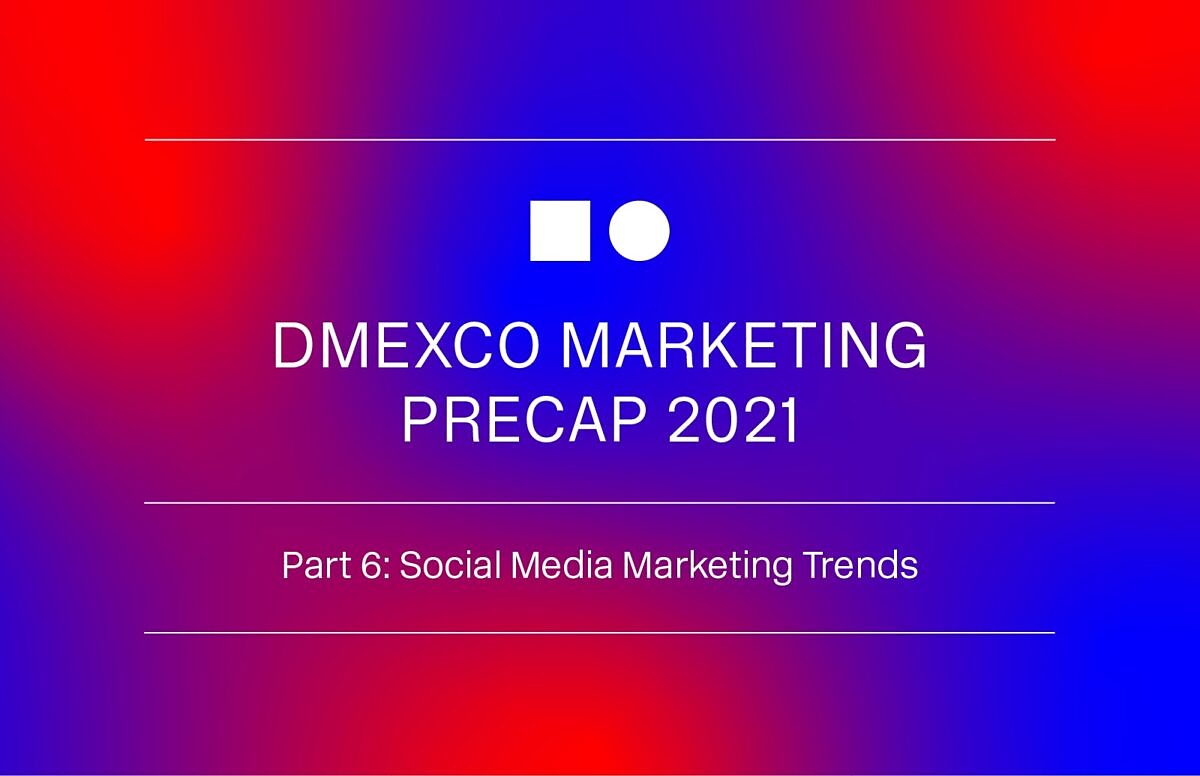DMEXCO marketing precap part 6: Social media marketing trends for 2021
The social media marketing trends for 2021 have been shaped by changing user behavior, new developments in technology, an expanded user base and – last but not least – the ongoing coronavirus pandemic. These are the trends to be aware of!

Social media marketing trends for 2021: Change in 3 dimensions
Have you planned your social media budget for 2021 and are you busy preparing your social media editorial plan for the new year? You might want to take a moment to familiarize yourself with developments that will shape social media marketing in the year ahead. Don’t worry – the social web marketing potential is far from exhausted, and you don’t have to rethink either your posts or your stories!
All the trends awaiting social media marketers in 2021 are determined by changes – some strong, some less so – within the 3 fundamental dimensions in the social media universe:
- Changes in user behavior
- Advances in technology
- Increase in generations and thus target groups in the consumer base
The setting is very similar to the one Michel Ramanarivo outlined in his discussion on the performance marketing trends of 2021: new media formats, new target groups, changes in user behavior among younger users, and new features may initially present challenges for companies and their marketing departments, but implementing the appropriate social media strategy will open up new opportunities.
More staying power than any trend: the coronavirus
You really don’t need a crystal ball to know that the coronavirus will keep us on our toes for quite a while yet, well into 2021. COVID-19 will also continue to significantly impact brand communication and thus brand communication on the social web as well. The 4C model is now frequently cited in content marketing, with the 4 Cs standing for:
- Community
- Contactless
- Cleanliness
- Compassion
An Instagram post by Deutsche Bahn is a good example, even though very few companies won’t have posted at least one coronavirus-related social media message in 2020. The post is purpose-driven and conveys a spirit of charity along with creating a strong marketing impact in favor of Deutsche Bahn. It also checks off at least three of the 4 Cs: community, contactless and compassion in relation to the coronavirus.
Content relating to the coronavirus or behavior during the crisis that hits an appropriate tone will continue to be popular in 2021.
New channels and formats: Brands put on the spot
While a recent survey commissioned by DMEXCO and conducted by Civey showed that the majority of companies are still wary of TikTok, those brands that are already leveraging the potential of the app stand to reap even greater benefits. The Washington Post represented by Dave – who is a hit with their target group and a prime example of how to use TikTok for marketing purposes – is evidence that even old stagers can use new channels to transform themselves into brands loved by a whole new generation of users:
@washingtonpost Stimulus talks could spill into the weekend as lawmakers are scrambling to complete the deal ##ReliefPackage
♬ original sound - Jezar Riches
Examples like this one from the USA demonstrate that new social media formats are the ideal channels for strong yet slightly outdated brands to reach their target groups, build a following, and even undergo something of a rejuvenation. We can assume that significantly more German and European brands will also take advantage of this opportunity in 2021 – for some of them, it could even be crucial for their survival.
But this example also shows that this approach will only succeed if brands pick someone that people can identify with. Corporate influencers will be more in demand than ever as a way of using the new communication channels to give brands a face that is appropriate for that particular channel and target group and – above all – is authentic. Many companies of all sizes, small, medium and large, will have to completely rethink their brand communication.
Wanted: corporate influencer! Brands need to become compelling stories that are told authentically by familiar faces.
How is user behavior changing?
Younger users are no strangers to using platforms and features like TikTok, Instagram Reels, and Koji in their private sphere, where they can take interesting content and add their own creative flair to create something fresh and unique. Users – who tend to still be very young – share the results of this remixing process directly to the corresponding channels. So far, few companies have utilized this trend for their own marketing purposes, but if they succeed in providing branded templates for users in 2021, then these features will become hugely attractive from a marketing perspective.
And don’t forget about nostalgia
You may be wondering in horror whether the resurgence of the crimes against fashion of the 90s isn’t bad enough, without these social media trends adding to it: Nostalgia marketing. On social media? It’s true that many well-known brands are adapting and expanding the retro trend. Nostalgic feelings that invoke rose-tinted memories of the good old days, when things were allegedly so much better, are simply a marketing gimmick that might have very little to do with retro, but that is exceedingly effective!
The coronavirus crisis has and continues to put many ordinary people in extraordinary situations. Everything we took for granted has been swept away and much of what was well-known and familiar no longer exists. As a result, we crave security, safety, guidance, freedom, health, and enjoyment of life. Social media marketing campaigns use images and sounds to pick up on all of these longings. Brands that have been around for a long time already and can associate their history with users’ memories of the good old days can jump on the nostalgia bandwagon and secure their future.
Conversational marketing: Dialog and chatbots
Developing your own chatbot and using it as an effective tool to build customer loyalty and achieve marketing objectives is now easier than ever. Personalized and automated chatbots are becoming more and more popular in social media messaging apps, not just on company websites or in online stores.
Gamification of the social web: Social gaming
In 2020, the pandemic robbed us of the opportunity to experience brands in real life – no in-store shopping, no sales talks, no trade fairs or events. As a result, many brands have been unable to use experiences to attract their target group and build their loyalty to the brand. Gamification appears to be the top choice to fill this gap – and it is going from strength to strength. This trend will continue intensively in 2021, with interactive competitions, games and challenges creating a realistic brand experience.
In addition, the gaming industry itself has long since built its own communities, which could be interesting as a target group for marketers. Online gaming has been a popular pastime during the pandemic, as well as an opportunity to connect with other gamers. It’s a long time since Twitch was the sole offering – Facebook Gaming now has more than 200,000 users a week, making it one of the world’s biggest cloud gaming platforms.
Meme marketing
Memes are rapidly becoming a valuable social content marketing tool. Simple to create, humorous, visually effective, easy to digest and reassuring, memes are the perfect way for brands to score with users. To back up this assertion, here is a meme from the Pinterest account of Shane Adam Atkins. Warning – may contain cat content!
But make sure that you get the following parameters right when you create your own meme campaign:
- Natural language
- Target group relevance
- Timing (the meme has to be on trend)
- Cultural climate
If your meme strikes a chord with your target group, it will take on a life of its own; as well as going viral, it will also prompt users to get involved and independently incorporate and share the brand message in their own memes. Heinz Ketchup recently managed this, for example – even if it wasn’t completely intentional (keyword: UI vs. UX). So, definitely make sure that you have some social media monitoring tools ready at hand.
The woke minefield!
Companies are increasingly expected to have an opinion and take a clear stance on current sociopolitical questions and issues. Gen Z and Generation Alpha are environmentally aware and climate-conscious, anti-racist, value gender equality and the rights of the LGBTQ community – in short, they are “woke”. Many companies are deciding to use purpose-driven marketing or green marketing to address these needs and to present themselves as being committed to the causes of this target group.
Unfortunately, many companies have also had their fingers burnt. A few examples:
- Gillette, who aired an ad presenting the company as being interested in gender equality.
- Amazon, giving itself a green image.
- Amazon, again, presenting itself as a good Samaritan in terms of integration and inclusion by creating jobs for people.
- McDonald’s, whose attempt to position itself in favor of the Black Lives Matter movement in the USA failed dismally.
- Apple, campaigning for LGBTQ with its pride-themed watchstraps, which it deliberately doesn’t offer in Russia.
- adidas, by losing the only woman on its management board and then running the #shareherpower campaign.
And the list goes on and on. Social media users are quick to reveal any hypocrisy and opportunistic exploitation of current situations purely for marketing purposes. Brands that simply search out and exploit high-profile conflicts in the everyday public discourse all too frequently expose other weak spots – and there is always someone ready and waiting to find reasons for criticism.





